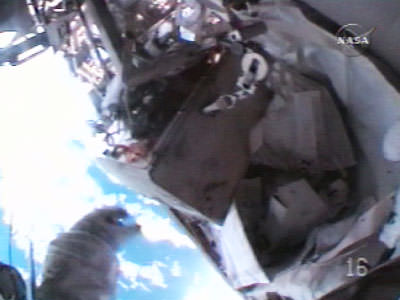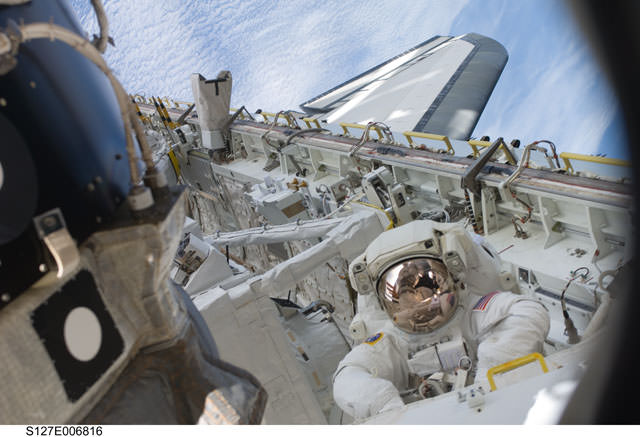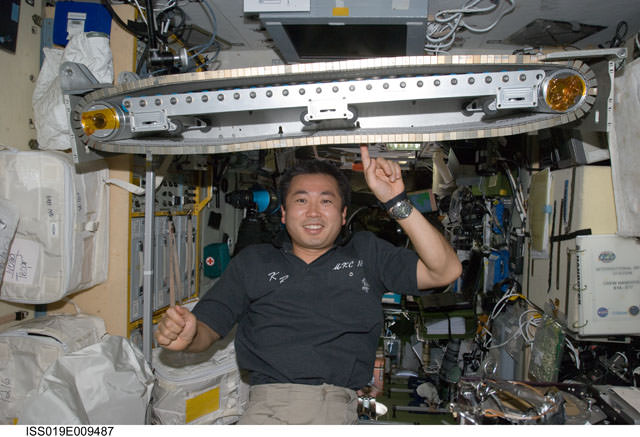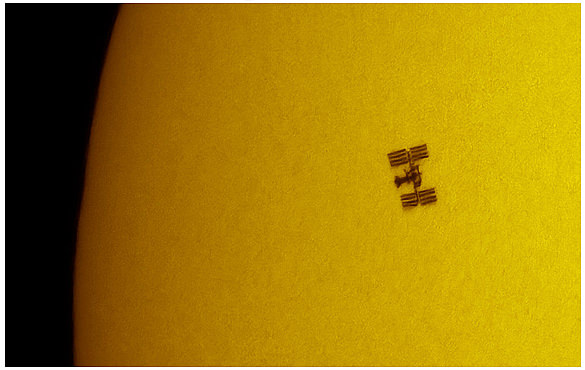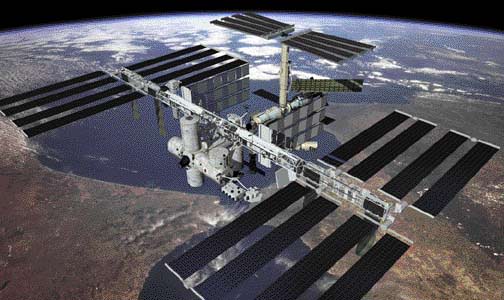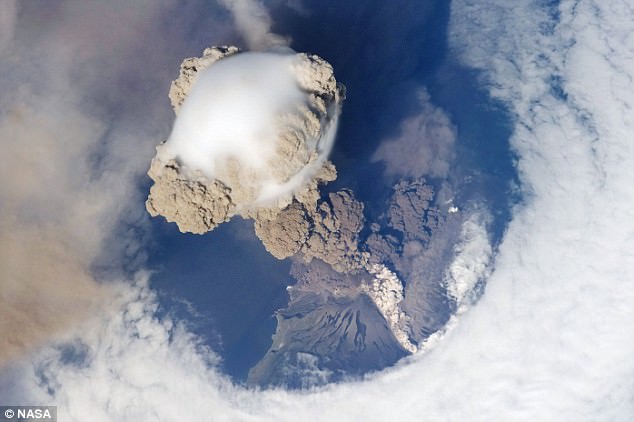[/caption]
The most famous toolbag in the world (and space) will soon be no more. The ISS Toolbag will enter Earth’s atmosphere and completely burn up. Current estimates say the toolbag should become a fireball on August 3 around 1316 Universal Time. It should be visible over the Pacific Ocean west of Mexico (12.7° N, 257.1° E). Astronaut Heidemarie Stefanyshyn-Piper dropped the backpack-sized kit on Nov. 18, 2008, while she was working outside the International Space Station. Since then the toolbag has circled Earth over 4,000 times, and has even been visible from the ground. Keep track of the toolbag at Heaven’s Above or on SpaceWeather.com’s Satellite Tracker.
Triple Spaceship Sighting Alert!
[/caption]
A great opportunity tonight (July 28) to see three spaceships cross the sky at once! Endeavour just undocked from the ISS today, so they will be close to each other, plus there’s another spaceship lurking nearby: a Progress re-supply ship ready to dock with the ISS. How can you find out when and where to look for the three spacecraft? There are a couple of different websites that provide real-time tracking data and information about the ISS sighting opportunities. See below for more info.
The image above is a screenshot from NASA TV of the ISS as Endeavour undocked. Notice the shadow of the shuttle on the ISS solar arrays!
NASA has a Quick and Easy Sightings by City site, where you just search for your country and city which provides local times and the location in the sky where the station will be visible.
The European Space Agency also provides their ISS: Where Is It Now site that also allows you to select your country and city to find the station’s location.
The Heaven’s Above website (which also powers ESA’s site) is also an excellent site to find out when the ISS, as well as all sorts of other satellites and other heavenly sights will be visible. At Heaven’s Above, you can plug in your exact latitude and longitude, so if you live in a remote area, you’ll be able to have exact times and locations to look for satellites instead of relying on information for the nearest city.
There’s also this very cool Google Satellite tracker.
Additionally, you can get a notification on Twitter when the space station will be zooming over your skies. Follow Twisst. (Thanks to big ian for the reminder of this new Twitter addition!)
Here’s wishing everyone clear skies and great views!
STS-127: A Mission in Pictures
[/caption]
As space shuttle Endeavour undocks from the International Space Station today (Tuesday), now is a good time to look back at the very successful STS-127 mission. Here’s some great images which tell the story of the mission. Above, astronaut Tim Kopra is pictured in the forward port side area of Endeavour’s cargo bay during the first of five planned spacewalks performed by the STS-127 crew. Kopra is now part of the ISS crew, and is staying onboard the space station to serve as flight engineer.
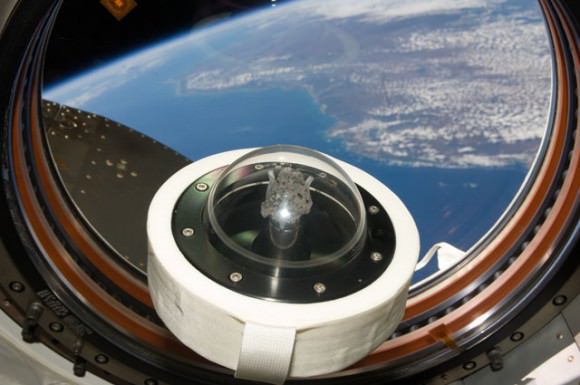
Of course, during this mission we celebrated the 40th anniversary of the Apollo 11 Moon landing. Fittingly, there was a Moon rock on board the ISS. The 3.6 billion year-old lunar sample was flown to the station aboard Space Shuttle mission STS-119 in April 2009. NASA says the rock, lunar sample 10072 serves as a symbol of the nation’s resolve to continue the exploration of space. It will be returned on shuttle mission STS-128 to be publicly displayed.
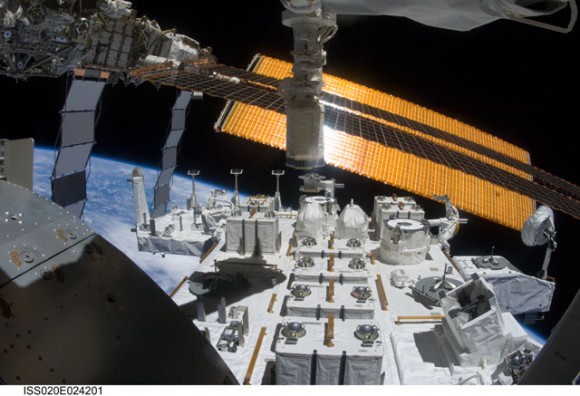
Here’s a view of the newly installed “front porch” of the Kibo lab, which is actually the Japanese Experiment Module – Exposed Facility (JEF). This platform will hold experiments designed to work outside the protective confines of the station, exposing them to the space environment. The JEF was installed by the astronauts during this mission.
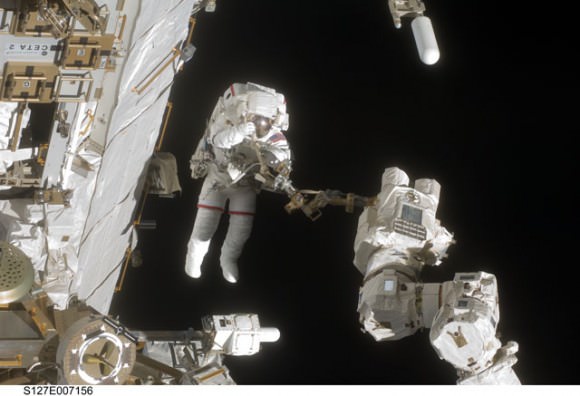
During the second STS-127 spacewalk, astronaut Dave Wolf worked outside bringing the Linear Drive Unit (LDU) and two other parts to the station’s External Stowage Platform 3 for long-term storage. Wolf is near the end of Canadarm2, which is anchored on the ISS.
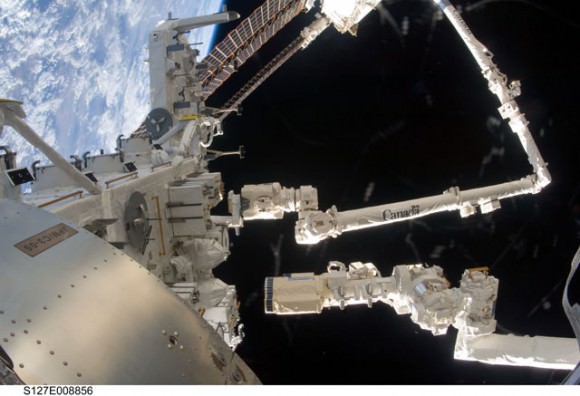
Speaking of the robotic arms, here’s a view of both the space station and space shuttle robotic arms as seen from inside the Kibo laboratory. A portion of the Japanese Experiment Module – Exposed Facility is also visible. The blackness of space and Earth’s horizon provide the backdrop for the scene.
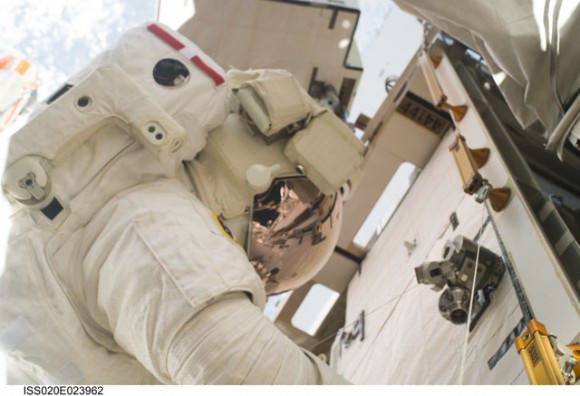
Astronaut Tom Marshburn makes his second spacewalk on July 24, along with Christopher Cassidy, out of frame. Eleven other astronauts and cosmonauts remained inside the International Space Station and the shuttle while the two astronauts worked outside.
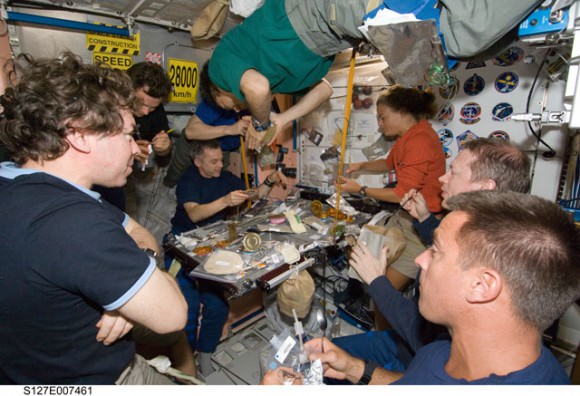
In total, there were 13 astronauts on board the ISS, a record for the amount of astronauts in one vehicle. Pictured, clockwise from bottom right, are astronauts Christopher Cassidy and Mike Barratt, with Russian Federal Space Agency cosmonaut Roman Romanenko, an unidentified crew member, Japanese Aerospace Exploration Agency astronaut Koichi Wakata (floating above), Canadian Space Agency astronauts Robert Thirsk and Julie Payette, European Space Agency astronaut Frank De Winne, and astronaut Christopher Cassidy. Either out of frame or not clearly seen are astronauts Mark Polansky, Doug Hurley, Dave Wolf, Tim Kopra and Tom Marshburn, plus Russian Federal Space Agency cosmonaut Gennady Padalka.
This screen shot shows the ISS as seen as Endeavour departed from the station on July 28. The views of both the ISS and shuttle were stunning. We’ll post the high-resolution versions when they become available. Notice the shadow of the space shuttle on the space station solar arrays! Amazing!

And now we’re back to the beginning of the mission. Liftoff for the STS-was at 6:03 p.m. (EDT) on July 15, 2009 from launch pad 39A at NASA’s Kennedy Space Center. The storm clouds stayed far enough away so that Endeavour and her STS-127 crew finally on its sixth attempt. Watch a replay of the launch here.
Long Duration Space Underwear
[/caption]
As Japan’s first astronaut to spend long duration missions on board the International Space Station, Koichi Wakata has had the opportunity to do all sorts of interesting experiments the past few months. For example, he conducted several different cellular growth and crystal growth experiments, and has even flown a magic carpet in space. One other experiment has been – shall we say – kept under wraps. Wakata has been wearing the same underwear on board the ISS for two months.
“(For) two months I was wearing these underwear and there was no smell and nobody complained,” Wakata, speaking in Japanese, said through an interpreter during a press conference this weekend from the ISS. “I think that new J-ware underwear is very good for myself and my colleagues.”
Wakata has been wearing special underwear and other clothing called “J-ware” designed for the Japanese space agency. According to an article in Discovery News, the clothes are treated with antibacterial and deodorizing materials. In addition to odor control, the clothes are designed to absorb water, insulate the body and dry quickly. They also are flame-resistant and anti-static — as well as comfortable and attractive.
Typically, clothes can only be worn for a few days in space, and especially the clothing worn by astronauts as they exercise. Since there’s no laundromat in space, the clothing is discarded as garbage.
Astronaut Takao Doi, who flew with a shuttle crew last year to deliver Japan’s Kibo laboratory to the station, exercised as much as his crewmates, but his clothes stayed dry.
Wakata’s clothes include long- and short-sleeved shirts, pants, shorts and underwear. Special socks have a separate pouch for the big toes so the astronauts can use their feet like an extra pair of hands, helpful for anchoring themselves on the floor while doing work on the station.
Originally, Wakata was scheduled to wear the underwear for just a couple of weeks. But obviously, he decided to go the long duration route.
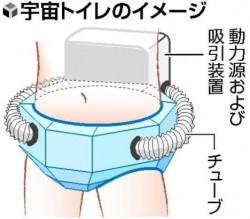
At least he wasn’t testing this other option proposed by JAXA. Read more about these special underwear here.
Wakata heads home with the crew of the STS-127 mission, undocking from the ISS today. The first landing opportunity is Friday, July 31.
Sources: Discovery News, Free Space
Stunning Image of ISS and Endeavour Transitting Sun
[/caption]
Wow! Take a look at this image captured by award-winning French astrophotographer Thierry Legault. The visible detail of the shuttle and parts of the International Space Stations is absolutely amazing! If you remember, Legault also took images of space shuttle Atlantis and the Hubble Space Telescope transiting the sun back in May during the HST servicing mission.
Legault is an engineer who lives near Paris. He started his digital imaging in 1994, and currently uses a SBIG STL-11000M CCD camera with AO-L system that is equipped with large and narrow band filters. He also uses a reflex Canon 5D, webcams from Philips as well as Astrovid video cameras.
He has written two books: “The New Atlas of the Moon” with Serge Brunier (Firefly) and “Astrophotographie” (Eyrolles), and is featured in a new book by Robert Gendler, “Capturing the Stars: Astrophotography by the Masters.”
Visit Thierry’s website for more great images!
Source: OnOrbit
Astronauts Don Protective Gear to Fix ISS Toilet
[/caption]
Space station astronauts repaired a broken toilet in the U.S Destiny laboratory today, avoiding a potentially messy situation. With the shuttle-space station complex currently home to a record combined crew of 13 astronauts and cosmonauts, fixing the toilet was of utmost importance. ISS crew members Gennady Padalka and Frank De Winne were told to don safety goggles and protective gear before opening the toilet’s access panels. They replaced a half-dozen components during work Sunday and Monday repairing the defective toilet with spare parts on the orbiting outpost.
While toilet repairs were going on, shuttle astronauts David Wolf and Thomas Marshburn completed the second spacewalk of the STS-127 mission, during a day filled with remembrances and tributes to the Apollo 11 moon landing.
The two astronauts transferred a spare KU-band antenna to long-term storage on the space station, along with a backup coolant system pump module and a spare drive motor for the station’s robot arm transporter. Installation of a television camera on the Japanese Exposed Facility experiment platform was deferred to a later spacewalk. This was the second of five STS-127 spacewalks, the 127th in support of International Space Station assembly and maintenance.
The STS-127 mission spacwalks will complete construction of the Japan Aerospace Exploration Agency’s Kibo laboratory.
The ISS has two toilets for its six-person crew, the one that malfunctioned in Destiny and another in the Russian Zvezda command module. The space shuttle Endeavour also is equipped with a toilet.
After tests to make sure the toilet was operating properly, flight controllers cleared the combined 13-member shuttle-station crew to resume normal use.
“The US Destiny lab toilet has been repaired and checked out. The crew has been given a “go” to use it. All three toilets are working,” NASA said in a post on Twitter.
De-Orbit the ISS in 2016? Don’t Bet On It
[/caption]
There’s been a fair amount of outcry this week regarding a quote in the Washington Post from International Space Station program manager Michael Suffredini that the ISS would be decommissioned, de-orbited and destroyed in 2016. Suffredini made that statement to the Augustine Commission, the presidential panel reviewing NASA’s future plans, at a hearing in June. But please don’t think ditching the space station is a done deal. Fiscal year 2016 is currently when the existing agreements between the international partners – and the all-important funding – expire. Suffredini also told the panel that discussions with the partners indicate all involved would like to see station operations continue past FY2016. NASA spokesman Kelly Humphries told Universe Today that the heads of the participating space agencies recently reaffirmed their common interest in using the station “to its full capacity for a period that is meaningful for our stakeholders and its users.”
Additionally, Humphries said the international partners recently noted that as things stand now, a continuation of operations beyond 2015 wouldn’t be precluded by any significant technical challenges.
“NASA is working with the international partners to understand if there are any technical constraints to extending the life beyond 2016,” he said. “That’s the first step in confirming the belief that we don’t have any major technical concerns.”
The FY 2016 date was originally based on how long the station would be operational. That doesn’t take into account delays that have occurred in bringing various modules and hardware to orbit.
“Based on the projected design lifetime of the hardware that we have in orbit, the current International Space Station program baseline does have operations ending in fiscal year 2016, which is the end of calendar year 2015,” Humphries said. “However, there hasn’t been any policy decision made as to whether to continue or preclude any additional space station operations beyond 2016. And NASA hasn’t taken any action to preclude those operations.”
Humphries said that no one at NASA is going to speculate how long – or short – the station’s life might be. “NASA’s policy is not to make or allow any decision to be made that would cause the space station to be terminated on a particular date,” he said.
But as in all government sponsored space activities, funding is the biggest question mark. “The continued funding of the station is a decision that will be made by the leadership in the nations that are participating as partners in the endeavor,” Humphries said. However, he added, the heads of agencies did commit to work with their respective governments to assess whether or not they can support the station after 2015.
Suffredini simply laid out the course of action that would occur if agreements with the partnering nations were allowed to expire, which seems unlikely. As far as the funding, those details are up to the governments — and the taxpayers — of the participating nations. So if you have an opinion — one way or the other — make your voice be heard.
But what does Suffredini really think? As he told the Augustine Commission, “My opinion is it would be a travesty to de-orbit this thing.”
Sources: Washington Post, phone interview with Kelly Humphries
Shuttle is Go For Launch, But is the Weather?
[/caption]
With the fuel leak apparently fixed, space shuttle Endeavour is ‘”go” for launch for the STS-127 mission. But the weather could force another delay. Forecasters predict a 60 percent chance thunderstorms on Saturday evening at Kennedy Space Center, and Endeavour’s launch is scheduled for 7:39:35 p.m. EDT. “Bottom line from the team, everybody’s go for launch, we have no major issues at all,” said Mike Moses, director of shuttle launch integration at the Kennedy Space Center. “We’re in really good shape for launch. We do have some challenges with the weather, but we’ll just work through those.”
Two previous launch attempts on June 13 and 17 were scrubbed when a hydrogen vent line attached to the side of the tank began leaking during fueling. NASA engineers replaced a one-piece Teflon seal with a different and more flexible two-piece seal, and in a fueling test on July 1, no leaks were detected.
The 16-day mission will feature five spacewalks and complete construction of the Japanese Kibo laboratory, adding a platform to the outside of the module that will allow experiments to be exposed to space.
Endeavour’s crew consists of commander Mark Polansky, pilot Douglas Hurley, Canadian flight engineer Julie Payette, David Wolf, Christopher Cassidy, Thomas Marshburn and space station flight engineer Timothy Kopra .
New Twitter Page To Alert Followers: Look Up Now to See the ISS!
[/caption]
Want to know when to stop tweeting and look heavenward for a view of the International Space Station? Follow one more account, then.
Several websites carry information about the space station’s path through the sky, but until now there’s been no service to alert people when the station is near them.
Dutch journalists Govert Schilling and Jaap Meijers have built a Twitter page to let people know when to look up.
The international, manned space station ISS is so easy to see mainly because of its huge solar panels that reflect sunlight. Since the start in 1998 the space station has orbited the earth over 60,000 times.
A new series of exceptionally bright passes will start in Europe this week. Other continents too will see – weather permitting – many great passes, for instance on July 7 in the United States and July 10 in East Asia.
People using Twitter can now receive an alert when the ISS will be passing at the location in their Twitter profile. All they have to do is follow the Twitter account @twisst: www.twitter.com/twisst
Twisst may be the first service on Twitter that sends out such highly personalised information. Twisst sends an alert to every follower personally, wherever in the world that person may be. More technical details are available here. Click here for an example of what an alert looks like.
Volcanic Shockwave Captured by ISS Imagery
[/caption]
These images of Sarychev Volcano were popping up everywhere in the internet yesterday, but unfortunately I was out of intertube contact most of the day. But these images are too awesome not to share! Astronauts on board the International Space Station took these striking views of Sarychev Volcano (Kuril Islands, northeast of Japan) on June 12, 2009. Notice the shock wave around the edge of the volcano’s plume and the “hole” the clouds that the eruption caused. Sarychev Peak is one of the most active volcanoes in the Kuril Island chain, and it is located on the northwestern end of Matua Island. Here are few more images taken in sequence as the ISS flew 354 km (220 miles) overhead:
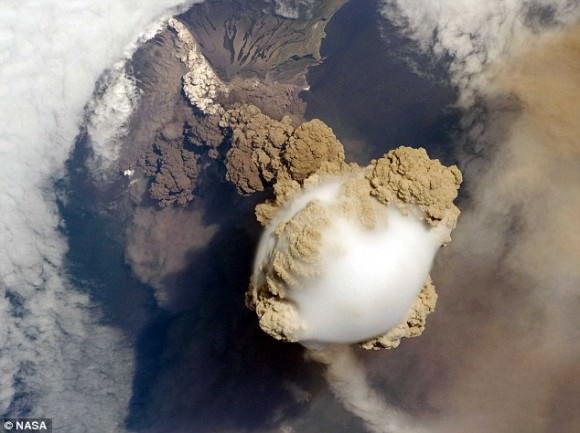
Volcanologists say these images are exciting because they capture several phenomena that occur during the earliest stages of an explosive volcanic eruption. The main column is one of a series of plumes that rose above Matua Island on June 12. The plume appears to be a combination of brown ash and white steam. The vigorously rising plume gives the steam a bubble-like appearance. The eruption cleared a circle in the cloud deck. The clearing may result from the shockwave from the eruption or from sinking air around the eruption plume: as the plume rises, air flows down around the sides like water flowing off the back of a surfacing dolphin. As air sinks, it tends to warm and expand; clouds in the air evaporate.
Also visible is material from the eruption falling down the slopes of the volcano.
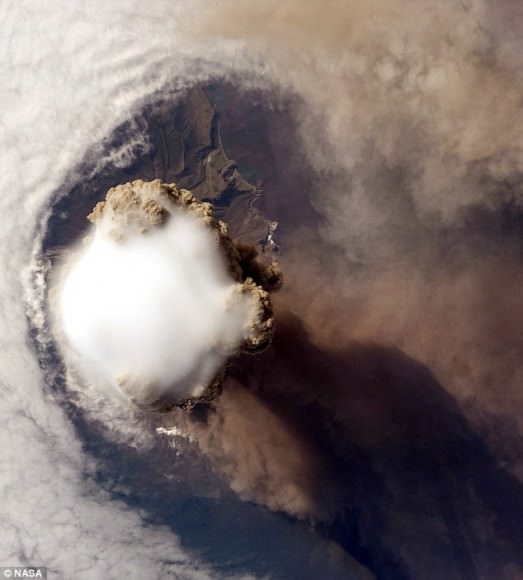
These images were taken by the Expedition 20 crew on the ISS, using a Nikon D2XS digital camera fitted with a 400 mm lens, and is provided by the ISS Crew Earth Observations experiment and Image Science & Analysis Laboratory, Johnson Space Center.
Source: NASA Earth Observatory

